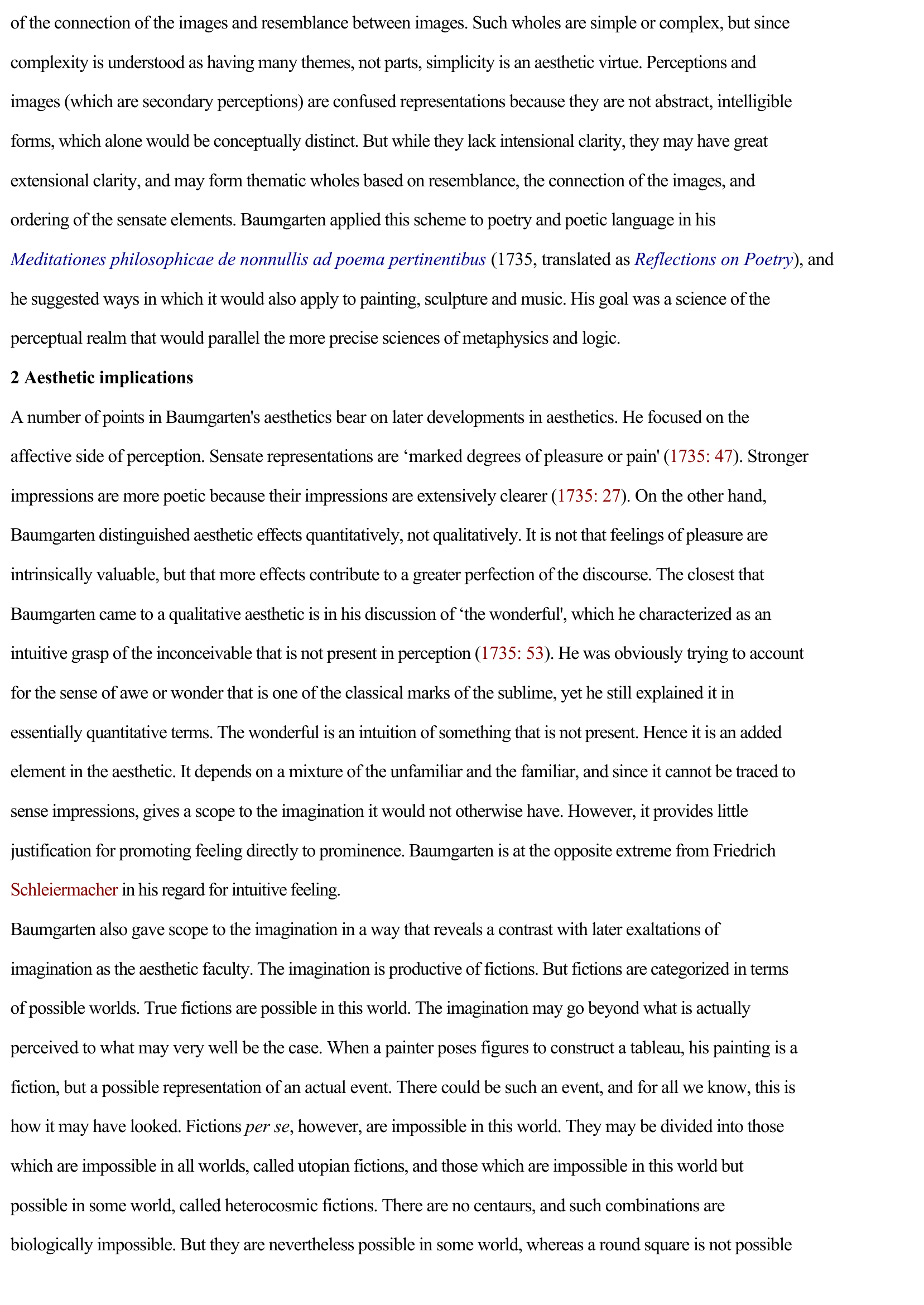Baumgarten, Alexander Gottlieb
Publié le 22/02/2012
Extrait du document
«
of the connection of the images and resemblance between images.
Such wholes are simple or complex, but since
complexity is understood as having many themes, not parts, simplicity is an aesthetic virtue.
Perceptions and
images (which are secondary perceptions) are confused representations because they are not abstract, intelligible
forms, which alone would be conceptually distinct.
But while they lack intensional clarity, they may have great
extensional clarity, and may form thematic wholes based on resemblance, the connection of the images, and
ordering of the sensate elements.
Baumgarten applied this scheme to poetry and poetic language in his
Meditationes philosophicae de nonnullis ad poema pertinentibus (1735, translated as Reflections on Poetry ), and
he suggested ways in which it would also apply to painting, sculpture and music.
His goal was a science of the
perceptual realm that would parallel the more precise sciences of metaphysics and logic.
2 Aesthetic implications
A number of points in Baumgarten's aesthetics bear on later developments in aesthetics.
He focused on the
affective side of perception.
Sensate representations are ‘marked degrees of pleasure or pain' (1735: 47 ).
Stronger
impressions are more poetic because their impressions are extensively clearer ( 1735: 27 ).
On the other hand,
Baumgarten distinguished aesthetic effects quantitatively, not qualitatively.
It is not that feelings of pleasure are
intrinsically valuable, but that more effects contribute to a greater perfection of the discourse.
The closest that
Baumgarten came to a qualitative aesthetic is in his discussion of ‘the wonderful' , which he characterized as an
intuitive grasp of the inconceivable that is not present in perception ( 1735: 53 ).
He was obviously trying to account
for the sense of awe or wonder that is one of the classical marks of the sublime, yet he still explained it in
essentially quantitative terms.
The wonderful is an intuition of something that is not present.
Hence it is an added
element in the aesthetic.
It depends on a mixture of the unfamiliar and the familiar, and since it cannot be traced to
sense impressions, gives a scope to the imagination it would not otherwise have.
However, it provides little
justification for promoting feeling directly to prominence.
Baumgarten is at the opposite extreme from Friedrich
Schleiermacher in his regard for intuitive feeling.
Baumgarten also gave scope to the imagination in a way that reveals a contrast with later exaltations of
imagination as the aesthetic faculty.
The imagination is productive of fictions.
But fictions are categorized in terms
of possible worlds.
True fictions are possible in this world.
The imagination may go beyond what is actually
perceived to what may very well be the case.
When a painter poses figures to construct a tableau, his painting is a
fiction, but a possible representation of an actual event.
There could be such an event, and for all we know, this is
how it may have looked.
Fictions per se , however, are impossible in this world.
They may be divided into those
which are impossible in all worlds, called utopian fictions, and those which are impossible in this world but
possible in some world, called heterocosmic fictions.
There are no centaurs, and such combinations are
biologically impossible.
But they are nevertheless possible in some world, whereas a round square is not possible.
»
↓↓↓ APERÇU DU DOCUMENT ↓↓↓
Liens utiles
- ÆSTHETICA, Alexander Gottlieb Baumgarten (résumé)
- Baumgarten (Alexander Gottlieb) Philosophe allemand (Berlin, 1714 - Francfort-sur-l'Oder, 1762).
- Baumgarten, Alexander - philosophie.
- THÉORIE DE LA SCIENCE (LA) ou DOCTRINE DE LA SCIENCE, Johann Gottlieb Fichte (résumé & analyse)
- SYSTÈME DE L’ÉTHIQUE D’APRÈS LES PRINCIPES DE LA DOCTRINE DE LA SCIENCE, Johann Gottlieb Fichte

































